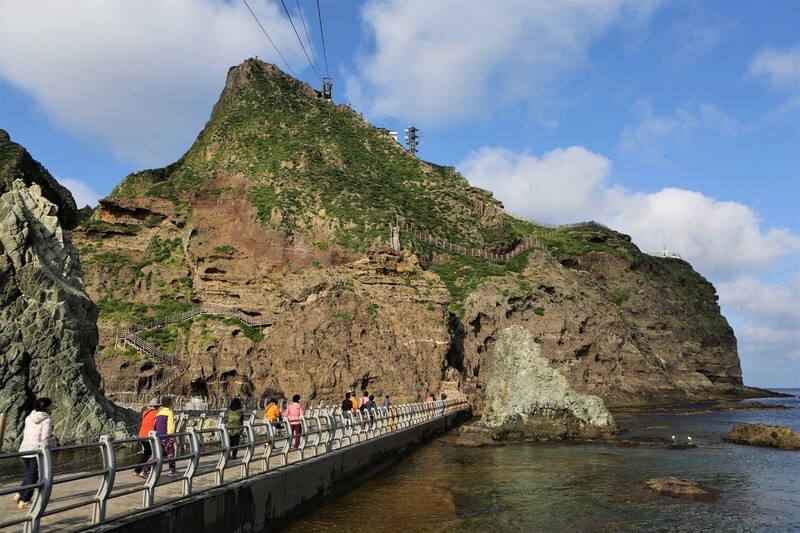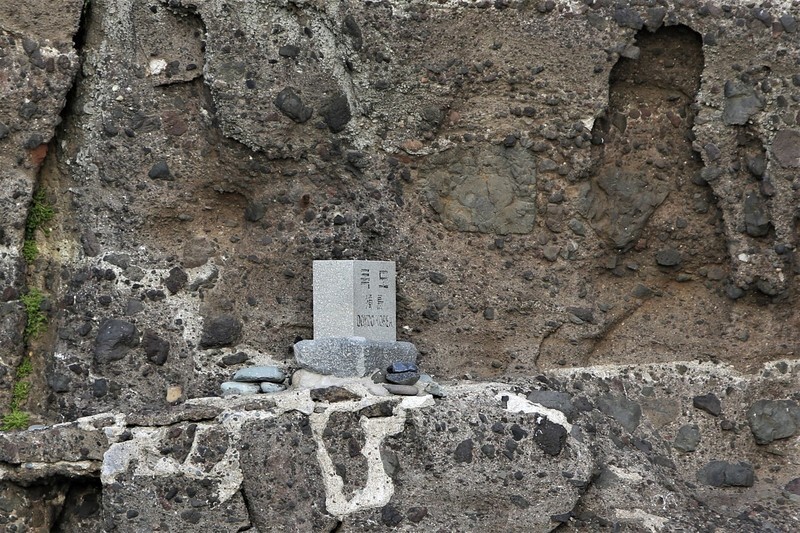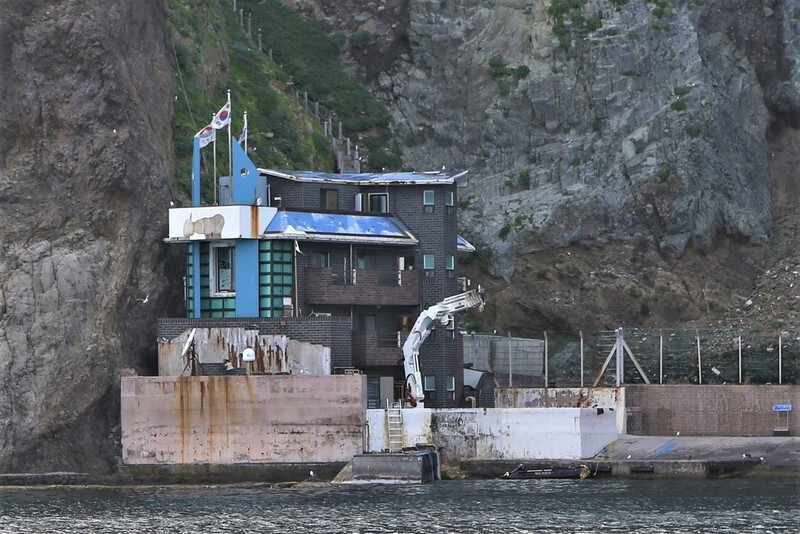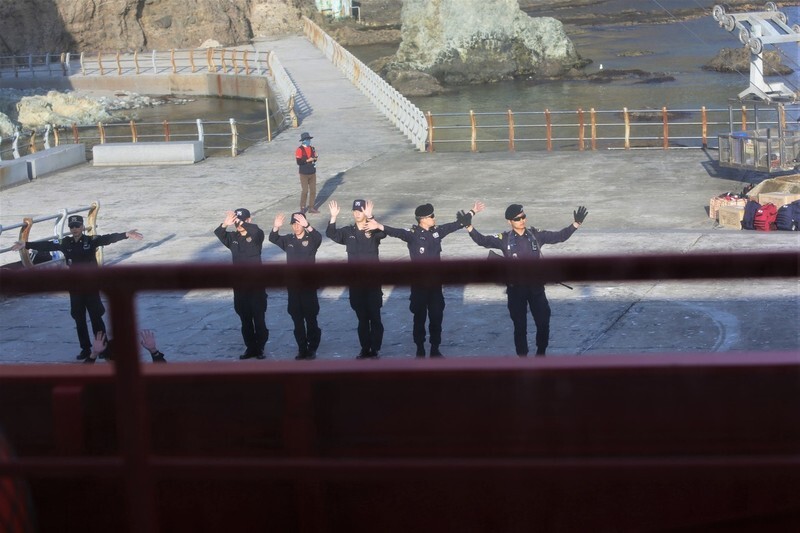hankyoreh
Links to other country sites 다른 나라 사이트 링크
[Reportage] Dokdo reveals itself to tourists 150 days a year

Dokdo is a place of the dawn. The islets are the first place in South Korea where the sun rises, the part of the territory where the day first dawns. On these beautiful islets at the eastern edge of South Korea’s East Sea waters, the first rays of sun off the land are welcomed by gulls, residents, security personnel, and lighthouse staff.
“Ladies and gentlemen, we will be arriving at Dokdo shortly.”
Luck was with us. The weather was clear, the sea was calm, and there had been no problems pulling in at the Dokdo dock. It had been an hour and 50 minutes since the Sunflower had departed Jeodong Port on Ulleung Island, traveling southeast at 60 kilometers an hour. As we prepared to disembark, another message came over the boat’s PA system.
“As a note, the coast guard that patrols Dokdo around the clock always complain there are not enough snacks. Please let us know if you have any snacks you are willing to provide as a care package.”
What is there not going to be a shortage of, when you’re healthy, hearty young man in your early twenties, braving the elements on an isolated islet out in the rugged East Sea? Dokdo has a permanent population of 47, including two residents, 40 security workers, two Dokdo Management Office employees, and three lighthouse keepers.

Opening Dokdo to the public
In the past, Dokdo had been difficult to visit even for those interested. It was in 2005 that it first became a travel destination for the general public, as the South Korean government lifted restrictions on arrivals on the islets. Previous landings had been restricted to those intended for environment and ecosystem protection purposes or security and safety. The first tourists setting foot on Dokdo’s dock were overcome with emotion, all of them waving South Korean flags they had brought along with them. Standing on a piece of attractive and valuable South Korean territory coveted by Japan, they sang full-throated renditions of the national anthem and the song “Dokdo Is Our Land.”
While nobody that day was singing the national anthem as in the past, they did seem just as moved to be standing on South Korea’s islets in the middle of the East Sea. After spilling out onto the dock, the tourists spent the 40 minutes permitted to them walking around and taking in everything they could – observing the shapes of the eastern and western islets and observing each new rock as they busily snapping pictures.
The visitors were confined to the area around the dock and could not see all of Dokdo’s contours. Yet they all seemed to be satisfied with what they could see: Tanggeon Peak, Candlestick Rock, Three Brothers Cave Rock, Chicken Rock, and other rocks of different shapes lined up near the distant islet; trees radiating green, rooted in a sheer cliff; and the glorious flight of a flock of black-tailed gulls nesting on the islets.
The visitors gazed plaintively at the home of Dokdo’s permanent residents Kim Seong-do, 78, and Kim Sin-yeol, 81, a married couple making do in a narrow cliff-base residence on the western islet. They also reached out to greet the Dokdo coast guard. “It must be tough guarding Dokdo,” they commiserated. The Kims had previously fished the area with Dokdo’s first resident Choi Jong-deok since the 1960s. After Choi passed away in 1987, they relocated to Dokdo, where they remain to this day.
The 40 minutes passed in an instant. As the message for them to board rang out, the tourists appeared disappointed as they filed onto the boat and waved to the coast guard lined up on the dock to see them off.

Difficulties of seeing Dokdo, despite easing of travel restrictions
Around 1,973,700 tourists visited Dokdo between 2005 and 2017. Not all of them actually set foot on the islets. In some cases, boats have been unable to dock due to foul weather, and tourists have had to content themselves with a tour around the periphery. Even now, landings on Dokdo are not completely free from time or other restrictions. Passenger service to Dokdo typically operates around nine months of the year, from February to November (not including winter months). During this time, Dokdo’s dock is said to be accessible for an average of 150 days – a little over half the time. The number of arrivals per day is restricted to within ten during the black-tailed gull’s breeding season in May and June.
I had been truly fortunate: my first trip to Ulleung Island in a long while, sunny weather, no seasickness – and an opportunity to take in the beauty of the eastern and western islets, to step on South Korean soil and see its value for myself.

Anyone planning a trip to Dokdo should make sure to stop at one of the free exhibition halls. Ulleung Island has three: the Dokdo Museum at Dodong, the An Yong-bok Memorial at Cheonbu Village, and the Dokdo Volunteer Forces Memorial Hall. A look around these three centers will provide clear evidence to back South Koreans’ vague ideas of Dokdo being “Korean territory,” while sharing a moving record of past individuals who risked their lives to guard the islets. The museums and memorial show in detail that Dokdo is unquestionably South Korean territory in historical and cultural terms – and that Japan’s claims to the contrary are false.
“I’m sure all of you naturally see Dokdo as being Korean territory, but why should Dokdo naturally be Korean territory?” the guide at the Dokdo Museum asked the visitors. When they hesitated, the guide proceeded to give a detailed explanation of the materials in the museum, described as “a place created to prove a clear answer to that very question.”

As I followed the guide around the museum’s five galleries and listened to the explanations, my previously vague understanding of Dokdo shaped into something more definite. The islands have traditionally been part of Korea’s territory: referred to as Usando during the Three Kingdoms and Goryeo periods (918-1392) and called Sambongdo, Gajido, and Dokdo during the Joseon period, they have accompanied Korea throughout its history and cultural developments. With Japan poised to invade the Korean Peninsula in 1905, it suddenly moved to incorporate Dokdo into its own territory, claiming the islets had no owner. Visitors to the museum can observe old Korean documents and maps, as well as old Japanese maps showing Dokdo as Joseon territory and information of the islets’ geological features and ecosystem.
In the media room, visitors can see images showing Dokdo and Ulleung Island in the 1950s and 1970s and residents’ way of life at the time. Particularly striking images show Ulleung Island’s natural environment and way of life as photographed in the 1960s by Humphrey Leynse (1921–1977), known as the “American who loved Ulleung Island.” A former information officer with US military, Leynse resided on Ulleung Island between 1966 and 1969, capturing black-and-white images of its residents’ varied lifestyles in a 62-minute archival feature titled “Out There a Lone Island.”

The Ahn Yong-bok Memorial was built in honor of the titular figure, who made great contributions to guarding Ulleung Island and Dokdo during the reign of King Sukjong (1675-1720) of the Joseon Dynasty (1392-1910). After Japanese fisherman began traveling to the area to fish, Ahn twice went to Japan (abducted by Japanese fishermen the first time, on a personal visit the second) to voice the position that Ulleung Island and Dokdo were Joseon territory and should not carelessly encroached upon by Japan. On display are images showing Ahn’s life and materials clearly demonstrating that Dokdo is Korean territory. Nearby is the recently opened Dokdo Volunteer Forces Memorial Hall, where visitors can learn about the activities of volunteer forces who dedicated themselves to guarding Dokdo against Japanese ambitions from the period between Korea’s liberation and the turbulence of the Korean War.
By Lee Byeong-hak, travel correspondent
Please direct comments or questions to [english@hani.co.kr]

Editorial・opinion
![[Column] Park Geun-hye déjà vu in Yoon Suk-yeol [Column] Park Geun-hye déjà vu in Yoon Suk-yeol](https://flexible.img.hani.co.kr/flexible/normal/500/300/imgdb/original/2024/0424/651713945113788.jpg) [Column] Park Geun-hye déjà vu in Yoon Suk-yeol
[Column] Park Geun-hye déjà vu in Yoon Suk-yeol![[Editorial] New weight of N. Korea’s nuclear threats makes dialogue all the more urgent [Editorial] New weight of N. Korea’s nuclear threats makes dialogue all the more urgent](https://flexible.img.hani.co.kr/flexible/normal/500/300/imgdb/original/2024/0424/7317139454662664.jpg) [Editorial] New weight of N. Korea’s nuclear threats makes dialogue all the more urgent
[Editorial] New weight of N. Korea’s nuclear threats makes dialogue all the more urgent- [Guest essay] The real reason Korea’s new right wants to dub Rhee a founding father
- [Column] ‘Choson’: Is it time we start referring to N. Korea in its own terms?
- [Editorial] Japan’s rewriting of history with Korea has gone too far
- [Column] The president’s questionable capacity for dialogue
- [Column] Are chaebol firms just pizza pies for families to divvy up as they please?
- [Column] Has Korea, too, crossed the Rubicon on China?
- [Correspondent’s column] In Japan’s alliance with US, echoes of its past alliances with UK
- [Editorial] Does Yoon think the Korean public is wrong?
Most viewed articles
- 1‘We must say no’: Seoul defense chief on Korean, USFK involvement in hypothetical Taiwan crisis
- 2Will NewJeans end up collateral damage in internal feud at K-pop juggernaut Hybe?
- 3[Column] Park Geun-hye déjà vu in Yoon Suk-yeol
- 4Why Korea shouldn’t welcome Japan’s newly beefed up defense cooperation with US
- 5Thursday to mark start of resignations by senior doctors amid standoff with government
- 6N. Korean hackers breached 10 defense contractors in South for months, police say
- 7[Guest essay] The real reason Korea’s new right wants to dub Rhee a founding father
- 8[Column] ‘Choson’: Is it time we start referring to N. Korea in its own terms?
- 9Kim Jong-un expressed ‘satisfaction’ with nuclear counterstrike drill directed at South
- 10[Editorial] New weight of N. Korea’s nuclear threats makes dialogue all the more urgent